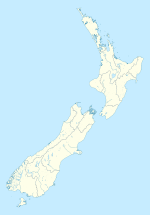Matangi, New Zealand
Matangi | |
|---|---|
Village | |
| Elevation | 50 m (160 ft) |
| Population (2013 census) | |
| • Territorial | 2,157 |
| Time zone | UTC+12 (NZST) |
| • Summer (DST) | UTC+13 (NZDT) |
Matangi is a settlement in the Waikato District on the eastern border of Hamilton. It is surrounded by many lifestyle blocks, but the village centre has Matangi School (opened 1910, with 141 students and 6 teachers),[1] a garage, Four Square, takeaway and café, Matangi Hall, St David’s church and Matangi recreation reserve.[2]
Demographics
Matangi had these census results -[3]
| Year | Population | Households | Average income |
|---|---|---|---|
| 2001 | 1,557 | 489 | $22,300 |
| 2006 | 1,791 | 597 | $29,100 |
| 2013 | 2,157 | 735 | $38,200 |
Geology
The area lies on Matangi soils,[4] formed on the edge of the Komakorau Bog and the Waikato's alluvial plains of sands and gravels.[5]
History

Sir George Grey Special Collections, Auckland Libraries, AWNS-19191120-38-1
The natural vegetation would have been mostly have been a mixed bush of totara, matai, rimu, kahikatea, titoki, tawa, and rewarewa. Virtually nothing remains of it.[6] Te Iti o Hauā marae, of Ngāti Haua, Ngāti Paretekawa and Ngāti Ngutu, is 3 km (1.9 mi) east of Matangi on Tauwhare Rd.[7] These original owners lost most of their land to confiscation or sales following the 1860s New Zealand wars.[8]
In 1884, the Cambridge branch opened with a station at Tamahere, renamed Matangi in 1906.[9] A creamery opened in 1885, then cheese factories and, in 1917, they amalgamated to form the New Zealand Dairy Association Group.[10] Further amalgamation followed and in 1919 New Zealand Co-operative Dairy Company Ltd opened its new dairy factory to produce dried milk for Glaxo. At the time it was the largest in the country, able to deal with 25,000 imp gal (110,000 L) a day.[11] It was an early customer of the Central Waikato Electric Power Board in 1921, when 12 local households were also connected.[12]From 1919 until its closure in 1987, the Matangi dairy factory also produced milk powder, condensed milk and cheese.[10]
Further rail sidings were added, along with a stationmaster and maintenance crews. In 1902, the first Matangi post office opened and in 1906, a telegram service was added, the school in 1910, bulk stores, marshalling yards and a community hall followed. After closure of the dairy factory, the post office and telephone exchange also closed.[2]
More recently, relaxation of subdivision rules have changed Matangi from a rural community to an area of rural residential development for Hamilton commuters.[13]
References
- ^ "Welcome to Matangi School | Matangi School". www.matangi.school.nz. Retrieved 2016-01-04.
- ^ a b "Matangi community". Waikato District Council.
- ^ "2013 Census map – QuickStats about a place". www.stats.govt.nz. Retrieved 2016-01-04.
- ^ "The Survey:- Soil Descriptions". www.nzsoils.org.nz. Retrieved 2016-01-04.
- ^ Lowe, D. J. (2010). "Introduction to the landscapes and soils of the Hamilton Basin" (PDF).
- ^ Theresa M. Downs, Bruce D. Clarkson, Beverley R. Clarkson (2007). "Indigenous Vegetation Types of Hamilton Ecological District" (PDF). Centre for Biodiversity and Ecology Research The University of Waikato.
{{cite web}}: CS1 maint: multiple names: authors list (link) - ^ "Welcome to Māori Maps". www.maorimaps.com. Retrieved 2016-01-04.
- ^ Taonga, New Zealand Ministry for Culture and Heritage Te Manatu. "Confiscation of Māori land". www.teara.govt.nz. Retrieved 2016-01-04.
- ^ "Matangi Post Office". Waikato Argus. 1914-06-17. p. 2. Retrieved 2016-01-07.
- ^ a b MOWBRAY, HARRY and ANDREW (2004). "MATANGI FACTORY HISTORIC PLACES TRUST RESTORATION PROPOSAL". Waikato District Council.
- ^ "Dried Milk Industry". New Zealand Herald. 1919-11-13. p. 8. Retrieved 2016-01-02.
- ^ Gilson, Chris (2005). Wiring up the Waikato. WEL Networks.
- ^ Wright, Jason (2006). "Change in local places: the experience of a peri-urban community" (PDF). Department of Geography University of Waikato.

